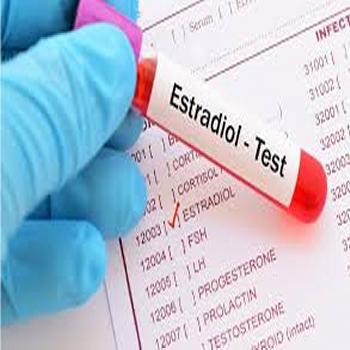What is Estradiol?
Estradiol (E2) is a key estrogen hormone involved in reproductive health for both females and males.
Purpose of the Test:
- To assess hormone levels related to fertility and sexual development.
- To investigate menstrual irregularities, symptoms of menopause, and other reproductive health issues.
Key Functions Affected by Estradiol:
- Development and function of the womb, fallopian tubes, and vagina.
- Growth of breast tissue and libido in both females and males.
- Erectile function and sperm production in males.
Normal Levels:
Women typically experience higher estradiol levels during their reproductive years, which decline significantly after menopause.
Potential Issues from Abnormal Levels:
- Menstrual problems and symptoms associated with menopause transition.
- Infertility and ovarian tumors.
- Gynecomastia (benign breast tissue swelling in males) and breast cancer.
Developmental Indicators:
The test can help detect early or late puberty in children, providing valuable information for diagnosis and treatment.
When to Order:
Physicians may request an estradiol test to evaluate abnormal sexual development or reproductive health concerns.
Why would I need an Estradiol Test?
An Estradiol Test may be recommended for several reasons, including:
Evaluating menstrual and reproductive health: To investigate irregular menstrual cycles, absence of periods (amenorrhea), or heavy bleeding (menorrhagia).
Fertility assessment: Estradiol levels are monitored in women undergoing fertility treatments (e.g., in vitro fertilization) to track follicle development and ovulation.
Evaluating menopause: To check estradiol levels in women experiencing symptoms of menopause, such as hot flashes, night sweats, or changes in menstrual patterns.
Diagnosing hormonal imbalances: To assess hormonal conditions like polycystic ovary syndrome (PCOS), hypogonadism, or estrogen-secreting tumors.
Monitoring hormone replacement therapy (HRT): For women on HRT, the test helps ensure estradiol levels are within the desired range.
Assessing puberty development: The test may help evaluate early or delayed puberty in children.
What do the results of an Estradiol Test indicate?
Normal estradiol levels: Estradiol levels vary based on age, sex, and, in women, the phase of the menstrual cycle or menopausal status:
Premenopausal women: Levels typically range from 30 to 400 pg/mL, depending on the cycle phase.
Postmenopausal women: Levels usually fall below 30 pg/mL.
Men: Normal levels are typically between 10 and 50 pg/mL.
High estradiol levels:
In women, high levels may indicate conditions such as ovarian tumors, PCOS, or estrogen-secreting tumors.
In men, elevated estradiol can be associated with conditions like gynecomastia (enlarged breast tissue), liver disease, or hormone-secreting tumors.
Low estradiol levels:
In premenopausal women, low levels can be a sign of hypogonadism, menopause, or failure of the ovaries to produce sufficient hormones.
Low estradiol in both men and women can affect bone health, leading to osteoporosis if left untreated.
